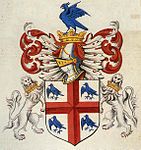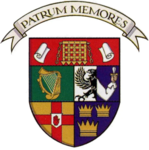Category:British tradition
British heraldry (or more precisely Anglo-Irish heraldry) is a collection of similar traditions, encompassing both the tradition practiced by the College of Arms, as well as the Irish tradition practiced by the Office of the Chief Herald of Ireland. The Anglo-Irish tradition is also the main tradition of Australia, New Zealand as well as most of the Commonwealth and the most important basis for heraldry in Canada, The United States and South Africa.
Features
Anglo-Irish heraldry is known to feature generally more animal-based and detailed crests than most continental traditions. It also Traditionally, women are expected to utilise a lozenge or oval instead of a traditional escutcheon. The English tradition, while having a system of cadency, does not enforce said cadency. Nonetheless cadency is very often practiced and quartering is usually applied when possible. It also allows individuals to bear identical escutcheons, as long as each achievement is unique (i.e. if there are two identical escutcheons, the crests must be different). The Irish tradition, being imported to the island from England, is largely similar but with the addition of sept arms, which allow some relations of the bearer of the senior armiger to display their arms freely. Mantling in the Irish tradition is typically Gules doubled Argent. Armigers in both traditions may utilise a badge and standard, as well as their achievement.
-
The Coat of Arms of Sir Winston Churchill
-
Coat of arms of Arthur Charles Fox-Davies
-
Coat of Arms of Coat of Arms of Kate Middleton. Before becoming the Duchess of Cambridge
Authorities
-
The College of Arms
(England and the British Commonwealth (except Canada, Scotland and South Africa)
Pages in category "British tradition"
The following 41 pages are in this category, out of 41 total.
#
- Andromeda
- Bloop
- VarsityChap
- Gnib
- Gadoneus
- John Morales
- Lev D.
- PirateVikingNinja
- Novov
- Whittier Strong
- Snak
- thomasjb2002
- Xavier Robinson
- Aviana (KnightofAshes)
- Matt
- John Clark
- Sixpencestreet
- Neil Thompson
- Matthew John-Lawrence Culley
- Adam Jai Gallant
- Dylan Francis Epp
- Madison Swooper
- Nathan Rhodes
- Michael Cunningham
- Darren McSweeney
- 20CaptainX12
- Thornwell
- woden_spoon
- Michael C
- Kimberly_111
- David Robert Wooten
- Siggs
- Give Tea
- abf
- Ok-Method-019
- Chelsey 'Dinah' Hayes
- RedRyderINW
- Daniel Cranfill
- Eric Paul Lafferty
- Chance Hudson
- Louis Barratt


